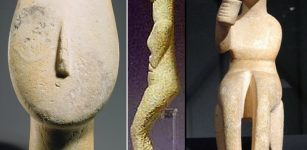Artemisia I Of Caria – Pirate Queen And Ally Of Xerxes I Was Loyal To No-One Except Herself
Ellen Lloyd - AncientPages.com - In ancient Greece, women had limited rights, and they were considered less valuable than men. Greek Queen Artemisia I of Caria was luckier than lower-class women because her status offered more freedom, influence, and power.
Artemisia at the Battle of Salamis. On the identification with Artemisia: "...Above the ships of the victorious Greeks, against which Artemisia, the Xerxes' ally, sends fleeing arrows...". By Wilhelm von Kaulbach.
Credit: Public Domain
Artemisia I of Caria, who reigned between 484-460 B.C.. was an intelligent and courageous woman who showed no fear in battles. She was respected by Xerxes I, King of Persia, who made her an ally.
Several historians have debated her feelings towards Greece and Persia. She plundered both Greek and Persian ships, and she seemed to be loyal to no-one except herself.
Who Was Artemisia I Of Caria?
Much of our knowledge about Artemisia I of Caria comes from the writings of ancient Greek historian Herodotus (84 BC – c. 425 BC.)
Born in Halicarnassus, an ancient Greek city in modern-day Bodrum in Turkey, Artemisia was the daughter of Lygdamis of Halicarnassus ( 520–484 BC), the first tyrant of Caria under the Achaemenid Empire that was founded by Cyrus the Great.
The Achaemenid Empire was not only the first Persian Empire but also the world's largest empire. In 480 B.C, the empire accounted for approximately 49.4 million of the world's 112.4 million people. At that time, the number was equal to 44% of the world's entire population! This was thus by no means a small and defenseless empire.
Rock relief of Xerxes at his tomb in Naqsh-e Rustam. Credit: Public Domain
Who Artemisia's mother was, has never been historically documented.
Artemisia became a ruler after her husband's death. She was left with a young son, but this didn't stop her from becoming a pirate.
"Ancient Mediterranean piracy was not identical to the modern conception of piracy. These ancient pirates were not bands of outlaws who swore allegiance to no one; they were more like enemy powers who raided other city-states on both land and sea.
Their methods, however, would be copied by more modern pirates—methods such as lying in wait for their prey, plundering large merchant ships, and using the geography of the area to their advantage. More important, these ancient pirates set the tone for more modern pirates, who would likewise follow their desire for riches to the sea and take them by any means necessary. Piracy was more accepted in ancient times than it is today because it was more like intertribal warfare than nationless piracy, "Laura Sook Duncombe explains in her book Pirate Women.
Artemisia Was The Only Naval Officer Who Advised Xerxes I Against The Battle Of Salamis
When Artemisia's city Caria fell under Persian control, she participated in several battles as a Persian ally. As a queen, she had many responsibilities, such as engaging in a war against rival city-states. She did not just command her fleet but often took the helm of her ship.
Artemisia I of Caria was a good strategist and could anticipate possible dangers, better than many other military officers. She had been sailing with Xerxes I, King of Persia, for some time and knew his goal was to conquer all of Greece. As Duncombe stated, "Xerxes was very concerned about his chances in a naval battle. His Persians were not particularly skilled sailors. Their capital city, Sula, was nearly a thousand miles from the sea, and they had not even had a navy of their own before the war."
Battle of Salamis (Die Seeschlacht bei Salamis). Artemisia appears highlighted center-left of the painting, above the victorious Greek fleet, below the throne of Xerxes, and shooting arrows at the Greeks. Wilhelm von Kaulbach. Credit: Public Domain
Before the Battle of Salamis, Xerxes I gathered all his officers and asked them whether he should engage in the battle or not. All his naval officers said the Persian army should fight against the Greeks. Artemisia was the only naval officer who advised Xerxes I, King of Persia against engaging in the Battle of Salamis, the first great naval battle recorded in history.
Xerxes I listened to her and her arguments but decided to follow the advice of his naval officers who showed support for the battle. This was a fatal mistake. During the Battle of Salamis, the Greek commander, Themistocles, lured the Persian fleet into the narrow waters of the strait at Salamis, where the massed Persian ships had difficulty maneuvering. The Greeks then attacked furiously, ramming or sinking many Persian vessels and boarding others. The Greeks sank about 300 Persian vessels while losing only about 40 of their own.
Winged female figure in kneeling-running stance, holding kerykeion and victory wreath, on the coinage of Caria around the time of Artemisia. Credit: Classical Numismatic Group, Inc., Wikipedia, CC BY-SA 3.0
The rest of the Persian fleet was scattered, and as a result, Xerxes I had to postpone his planned land offensives for a year, a delay that gave the Greek city-states time to unite against him.
The Persian king's fleet was defeated, but Xerxes I had now an even higher opinion of Artemisia's military skills and he praised her for her leadership in action during his fleet's defeat. During the Battle of Salamis in September 480 B.C. Artemisia I Of Caria led the forces of Halicarnassos, Cos, Nisyros, and Calyndo. She supplied five ships, and according to Herodotus, "her ships were reputed the best in the whole fleet after the ships of Sidon; and of all his allies, she gave the king the best counsels."
Artemisia's Clever Trick Fooled The Greeks
On one occasion, Artemisia's ship was followed by the Greeks. When she felt she couldn't escape, she fooled the Greeks. She quickly ordered the Persian colors to be taken down and fired on a Persian ship. Her cunning tactical maneuver misled the captain of the Athenian ship. He was a little confused at first, but he realized he must have made a mistake. Artemisia's ship must have been either a Greek ship or it was deserting from the Persians and fighting for the Greeks. Not knowing that Artemisia was on the ship, he ceased the pursuit, and she was free.
The Jar of Xerxes I, found in the ruins of the Mausoleum at Halicarnassus, may have been offered by Xerxes to Artemisia I, who had acted with merit as his only female Admiral during the Second Persian invasion of Greece. Credit: Public Domain
After the Battle of Salamis, Xerxes I sought Artemisia's advice. Should he lead troops to the Peloponnese himself, or withdraw from Greece and leave his general Mardonius in charge?
Artemisia told the Persian king the best cause of action for him was to retreat back to Asia Minor. She supported Mardonius' plan who requested 300,000 Persian soldiers who would defeat the Greeks in Xerxes' absence.
This time Xerxes I followed her advice. According to Herodotus, the Persian king left his general Mardonius in charge and sent Artemisia to Ephesus, where she took care of his illegitimate sons.
This was a good agreement because her lands did well by their alliance with the Persians.
Whether Artemisia I Of Caria really gave up seafaring life to care for Xerxes's sons is uncertain. However, she did keep a much lower profile and maybe even retired, fearing her treachery against Xerxes I could one day be revealed. Whether she destroyed a Persian ship during the Battle of Salamis is unknown, but she did fire, which would not have pleased Xerxes I.
Updated on April 12, 2022
Written by Ellen Lloyd – AncientPages.com
Copyright © AncientPages.com All rights reserved. This material may not be published, broadcast, rewritten or redistributed in whole or part without the express written permission of AncientPages.com
Expand for referencesMore From Ancient Pages
-
 Spells, Charms, Erotic Dolls: Love Magic In The Ancient Mediterranean
Featured Stories | Oct 24, 2022
Spells, Charms, Erotic Dolls: Love Magic In The Ancient Mediterranean
Featured Stories | Oct 24, 2022 -
 Strangest Maps Ever Created – You Have Never Seen Our World Like This!
Featured Stories | May 18, 2022
Strangest Maps Ever Created – You Have Never Seen Our World Like This!
Featured Stories | May 18, 2022 -
 Major Archaeological Discovery Of A 7,000-Year-Old Settlement In Miami – But Its Future Is In Danger
Archaeology | Feb 10, 2023
Major Archaeological Discovery Of A 7,000-Year-Old Settlement In Miami – But Its Future Is In Danger
Archaeology | Feb 10, 2023 -
 The Cyclades And Their Mysterious Society Lost In Time
Civilizations | Feb 4, 2016
The Cyclades And Their Mysterious Society Lost In Time
Civilizations | Feb 4, 2016 -
 ‘Golden Man’ – Sak Warrior Covered With Thousands Of Pieces Of Gold – More Light On Gold Techniques Used In Kazakhstan
Archaeology | Jan 9, 2019
‘Golden Man’ – Sak Warrior Covered With Thousands Of Pieces Of Gold – More Light On Gold Techniques Used In Kazakhstan
Archaeology | Jan 9, 2019 -
 Evidence Of Ancient Gigantic Tsunami That Struck Tel Dor Maritime City Mound, Israel
News | Jan 1, 2021
Evidence Of Ancient Gigantic Tsunami That Struck Tel Dor Maritime City Mound, Israel
News | Jan 1, 2021 -
 Who Was King Menes? Mystery Of This Legendary Ruler May Go Back 20,000 Years
Civilizations | May 1, 2017
Who Was King Menes? Mystery Of This Legendary Ruler May Go Back 20,000 Years
Civilizations | May 1, 2017 -
 Deciphered Dead Sea Scroll Reveals Secret Calendar And Two Events Not Mentioned In The Bible
Archaeology | Jan 23, 2018
Deciphered Dead Sea Scroll Reveals Secret Calendar And Two Events Not Mentioned In The Bible
Archaeology | Jan 23, 2018 -
 Ancient Mesopotamian City Lagash Reveals More Archaeological Secrets
Archaeology | Jan 25, 2023
Ancient Mesopotamian City Lagash Reveals More Archaeological Secrets
Archaeology | Jan 25, 2023 -
 Ukraine – A Place Where People From Different Cultures Intersected Until About 500 Years Ago
Archaeology | Jan 14, 2025
Ukraine – A Place Where People From Different Cultures Intersected Until About 500 Years Ago
Archaeology | Jan 14, 2025 -
 2,500-Year-Old Tibetan Medical Text Describes A Coronavirus-Like Outbreak In Surprisingly Accurate Details
News | Oct 26, 2020
2,500-Year-Old Tibetan Medical Text Describes A Coronavirus-Like Outbreak In Surprisingly Accurate Details
News | Oct 26, 2020 -
 Part Of Secret Vatican Manuscript Decoded
Archaeology | Sep 7, 2017
Part Of Secret Vatican Manuscript Decoded
Archaeology | Sep 7, 2017 -
 One Of Egypt’s Oldest Christian Churches Discovered By Polish Archaeologists
Archaeology | May 31, 2019
One Of Egypt’s Oldest Christian Churches Discovered By Polish Archaeologists
Archaeology | May 31, 2019 -
 Puzzling Markings Carved On Ancient Artifacts Discovered In North America – Unknown Native American Tribe, Lost Civilization Or Something Else?
Civilizations | Apr 26, 2018
Puzzling Markings Carved On Ancient Artifacts Discovered In North America – Unknown Native American Tribe, Lost Civilization Or Something Else?
Civilizations | Apr 26, 2018 -
 Rocket Launch Into Space At Sibiu, Romania Took Place In 1555 – Sibiu Manuscript
Ancient Technology | May 29, 2014
Rocket Launch Into Space At Sibiu, Romania Took Place In 1555 – Sibiu Manuscript
Ancient Technology | May 29, 2014 -
 Mysterious Ancient Circular Structure Discovered In Turkey – Has Zippalanda, The Lost City Of The Hittites Been Found?
Archaeology | Dec 27, 2022
Mysterious Ancient Circular Structure Discovered In Turkey – Has Zippalanda, The Lost City Of The Hittites Been Found?
Archaeology | Dec 27, 2022 -
 Babylon’s Kiln-Fired Bricks Almost Erased The City From History
Featured Stories | Dec 13, 2018
Babylon’s Kiln-Fired Bricks Almost Erased The City From History
Featured Stories | Dec 13, 2018 -
 Mysterious Biblical Celestial City And Its Connection To The North Star – Nonhuman Hands – Part 1
Biblical Mysteries | Feb 22, 2021
Mysterious Biblical Celestial City And Its Connection To The North Star – Nonhuman Hands – Part 1
Biblical Mysteries | Feb 22, 2021 -
 Emilia Plater: National Female Hero Of Polish And Lithuanian People
Featured Stories | Apr 21, 2017
Emilia Plater: National Female Hero Of Polish And Lithuanian People
Featured Stories | Apr 21, 2017 -
 Secrets Of Viking Crystal Sunstones Revealed By Modern Science
Archaeology | Apr 5, 2018
Secrets Of Viking Crystal Sunstones Revealed By Modern Science
Archaeology | Apr 5, 2018





